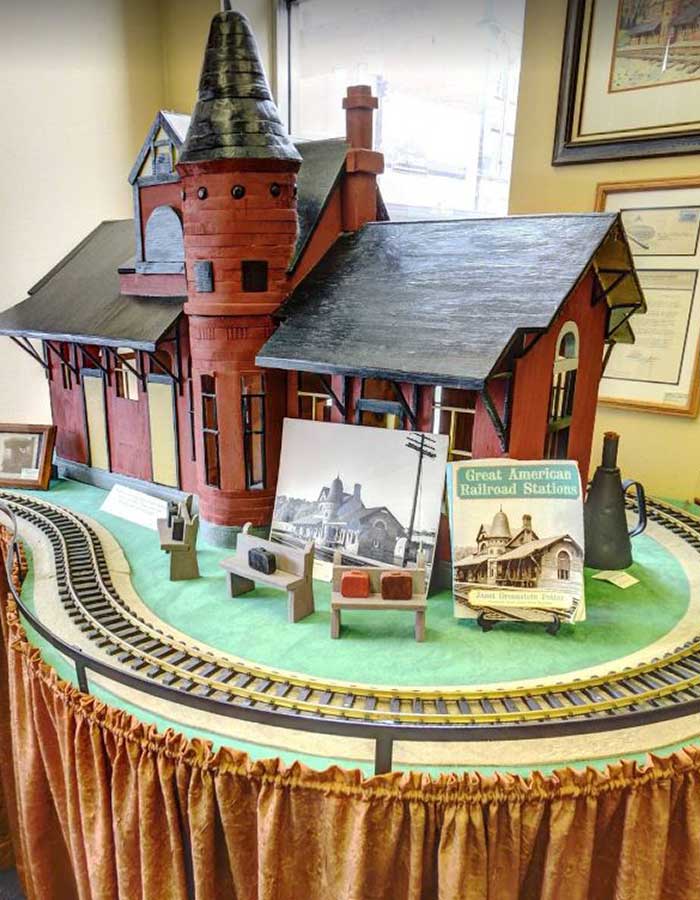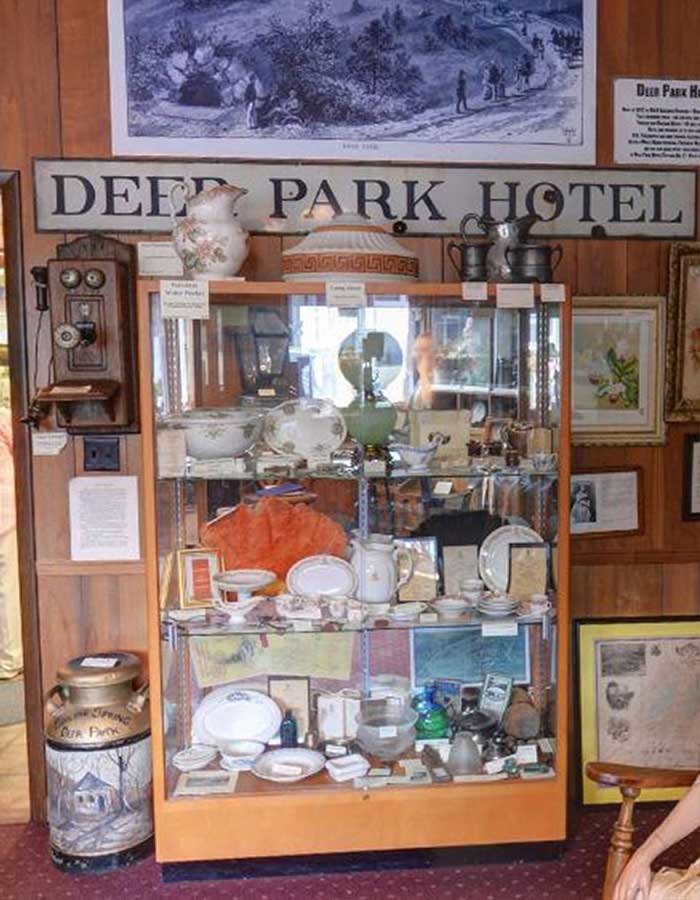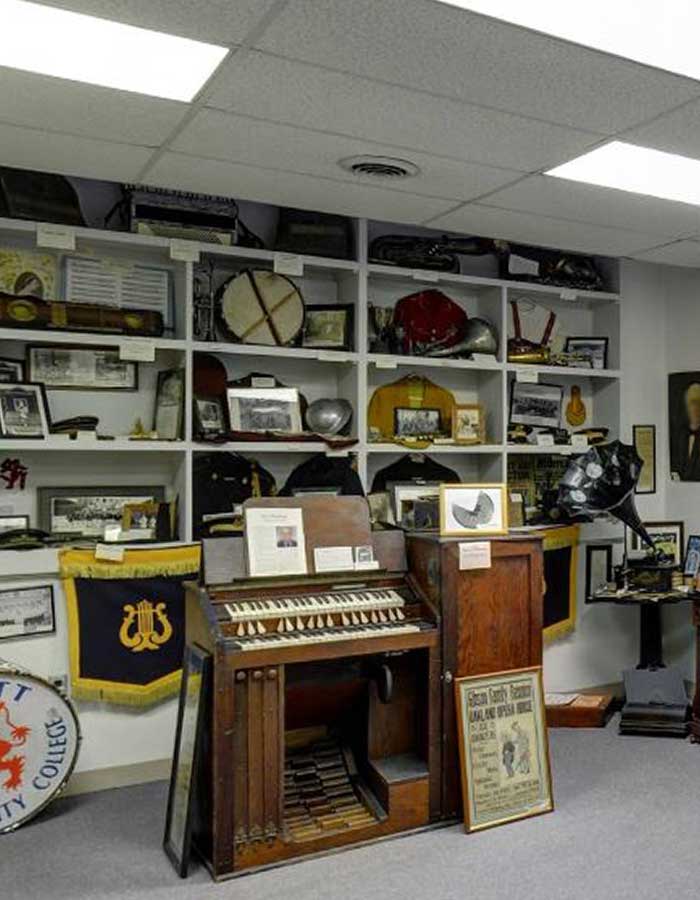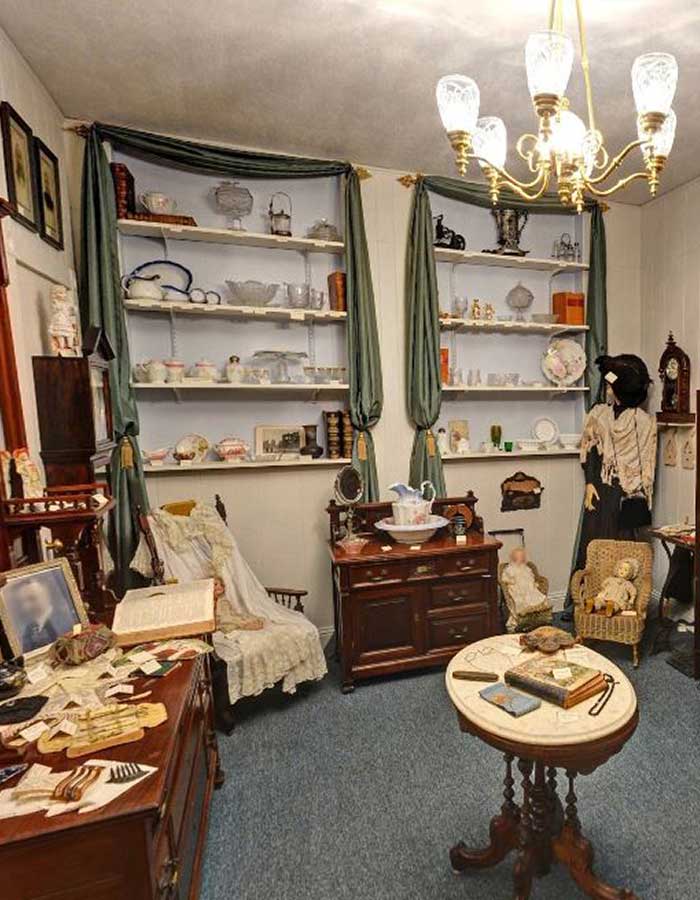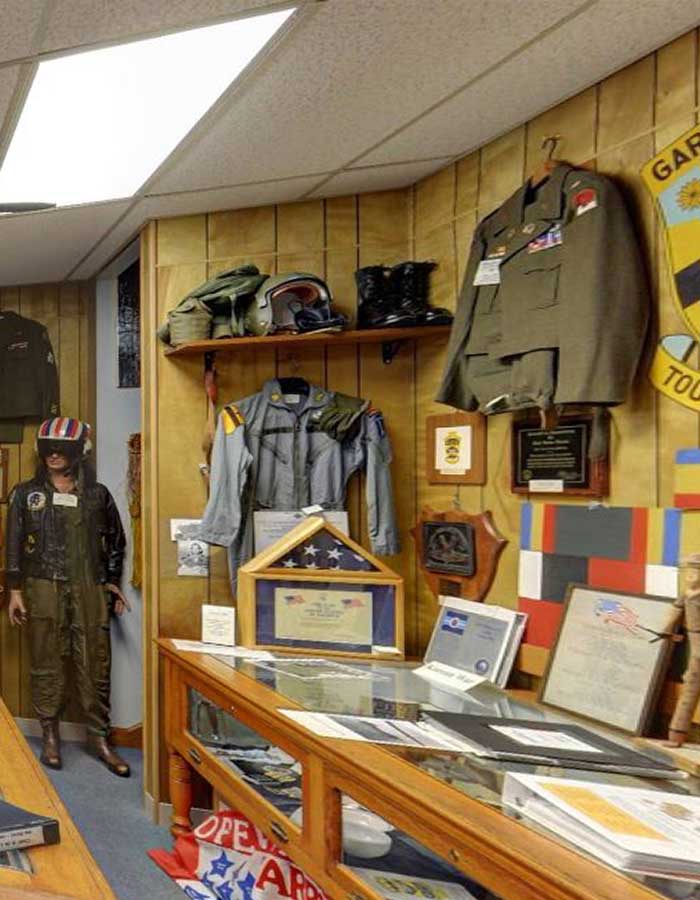Exhibitions
The Exhibitions feature 9 rooms, each showcasing a specific era in Garrett County History:
B&O / Garrett Room
Hotels Room
Schools Room
Arts & Recreation Room
Industrial Room
Victorian Room
Military Room
Cabin Room
Explore the rooms below!
B&O/Garrett Room
The B&O/Garrett Room offers a look into the life of John Garrett and the impact of the B&O Railroad in Garrett County.
The B&O was America’s first railroad and was started in Baltimore in 1827. Baltimore’s merchants and bankers funded the B&O as a means to connect Baltimore to the Ohio River, more than three hundred miles away. The investors were skeptical as to whether the railroad would ever function. As the first train was loaded on the tracks, the investors waited to see whether their money went to a success or just a novel idea by some wealthy businessmen. The engine traveled the tracks to the Ohio River with no problem and started the era of the locomotives. For years the B&O was the premier means of transportation, carrying everyone from Presidents to business owners to the occasional family who needed to make a trip to town.
The B&O was functional and now it needed a President. John Work Garrett was elected President in 1858 and traveled across the nation with the B&O. Garrett met many influential leaders during his travels, including President Abraham Lincoln. During a trip, Garrett had to stop in a small town in Western Maryland. Garrett loved the beautiful landscape and the rugged appearance of the town and built a cottage in Deer Park. In 1872, this small tract of land split from Allegheny County and formed its own county. Garrett County was named after John Work Garrett in honor of all his contributions to the area. Oakland was elected as the county seat and continues to serve as the central location.
Hotels Room
The Hotels Room takes a step back into the days of the glamorous Deer Park and Oakland Hotels, as well as several other small hotels, and how these hotels turned Garrett County into a luxurious vacation spot.
The success of the B&O Railroad led John Garrett to venture into a new frontier: hotels.
Garrett wanted the B&O to build a hotel in Deer Park and Oakland, but before construction could begin the Civil War broke out. The railroads were needed to carry supplies to the troops, and so the idea of luxury hotels in Garrett County was put on hold.
After the war, the Deer Park Hotel was built in 1873. The Oakland Hotel followed shortly in 1876.
The Deer Park Hotel was one of the most famous hotels in the country in the late 1800’s. It furnished a bowling alley, an 18-hole golf course, a tennis court, a riding stable, and 2 swimming pools (one for men and one for women). The Deer Park Hotel caught fire in 1944 and due to the fading popularity of the railroads for passenger travel, it was never rebuilt.
The Oakland Hotel was the second largest hotel to be built in Garrett County. The hotel was constructed closer to the railroad so passengers just staying for the evening would not have a long journey to and from the station. With about 12 trains a day stopping in Garrett County, the B&O decided to construct a hotel that would be used for shorter stays. One of the most notable events at the Oakland Hotel was the late 19th century stay by Alexander Graham Bell. He stayed for several weeks to hook up the first functional phone line in Garrett County between the Oakland and Deer Park Hotels.
Schools Room
The Schools Room, which also serves as the gift shop, features business and commerce in early Garrett County.
Arts and Recreation Room
Visitors’ fascination with the area’s beauty was matched by their allure of the Mountain Chautauqua or one of the many boys bands. One new and exciting feature to the area was an Opera House in downtown Oakland. The theatre was three stories tall and housed a restaurant on the first floor. The second floor was just for tickets and the box office and the third floor was the actual theatre stage and seating. On a night when a production was showing, there were at least a hundred horse drawn carriages lining the street.
This time of the arts was also marked by a time of desperation as the Great Depression of the 1930s hit Garrett County. President Roosevelt enacted the Civilian Conservation Corps (CCC) to help young boys earn money. The boys were given $1.00 a day for their work as well as given food, shelter, and a chance to finish their high school education. The boys lived in cabins near state forests and parks so they would be close to where they worked.
Another popular form of entertainment in Garrett County were the boys’ bands. Almost every town in Garrett County had a boy’s band where young boys were given the opportunity to learn to play a musical instrument and meet new friends. One of the more famous band directors was Henry Mickey of Crellin who directed one of the largest boys bands in the area.
Industrial Room
Garrett County has always had a strong background in the farming and mining industries. Since the county’s founding in the mid 19th century, a variety of farming tools have been used and developed in Garrett County. At the turn of the century another industry started to grow: mining. As the mining industry grew, so did the towns. It seemed every little town in Garrett County, at some point, had a mining store. One of the larger mining towns was Vindex, right outside of Kitzmiller. There were 5 coal companies who chose to operate out of Vindex. Currently only West Vindex still stands about a mile off Route 38. When the mines were operating, West Vindex had a population of about 150 people, whereas today only a few houses still stand in the area.
Mining and farming were and continue to be popular forms of industry in Garrett County. But, at the turn of the century a new kind of industry emerged: the trapping and fur industry. Bears proved to be a large problem to farmers and miners alike. They ate the farmers crops and often slept close to mine shafts and made it hard for miners to leave. In return, several farmers began to trap the bears and either sell the fur or release the bear into another area. But, as the fur industry grew the bear population shrunk and laws were enacted to stop the trapping and trading of bears. Currently, traps are only to be used by the DNR to trap bears and safely move them to a new location.
Victorian Room
The Victorian Room is an elegant journey back to the early 20th century when glamour and sophistication where found in every aspect of life. At the turn of the 20th century, the country was obsessed with the glamour and sophistication of the Victorian era. Families in Garrett County began to take note of what the rest of the country was doing and followed suite. Opera houses were one of the most popular forms of entertainment, women began dressing in the finest clothing, and it didn’t seem like a Saturday night without 50 carriages lining the street.
Have you ever heard the phrase, “Born with a silver spoon in his mouth?” This phrase literally means what it says. During the Victorian era, wealthy families began buying sterling silver spoons for their young children. If you were seen out using a silver spoon, others knew your family was wealthy. Class and sophistication was the look everyone was going for, even the china and glass companies. Some of the most beautiful pieces of china and glassware came from this era and are still in high demand in today’s world.
The Victorian Era was a time of elaborate design. The bed frame and other furniture was the centerpiece of a Victorian bedroom. Quilts from this era were made with elaborate fabrics, such as silk, and included intricate embroidery on almost every square.
Military Room
The USS Garrett County was launched and commissioned at the Dravo Shipyard on Neville Island in the Ohio River, just a few miles downstream from Pittsburgh. The boat was 428 feet long, had a 50 foot beam, was powered by two General Motors 900 horsepower diesel engines, and had a maximum speed of 12 knots. The USS Garrett County earned 12 combat ribbons, and carried troops in both World War II and the Vietnam War. The ship fled to the Philippines with the fall of the South Vietnam government, and ownership was transferred to the custody of the Philippines. The ship was renamed Kalinga Apayao and used by the Philippines for several years after.
The Civil War broke out just as Garrett County was thinking about becoming a separate county from Allegheny. The problem for most residents in Garrett County at the time was the fact that Maryland fell under the Mason Dixon line and therefore was mostly Confederate. Because it was more of a border state, they had both Union and Confederate armies in the state, Garret County wanted to be part of the Union. When West Virginia broke away from Virginia, Garrett County actually asked to become part of the new state. The Maryland government declined the proposal, and it was not until 1873 that Garrett County finally broke away from Allegheny.
Garrett County was also involved in the United States’ dispute with the Indians. The US government in the mid 19th century wanted to move the Indians from their homelands in the north to the plains of the west. The problem was that most of the Indian tribes were not willing to move from their homelands. In return, the government commissioned the army to forcibly move the Indians. Just as this “war” began, the B&O was gaining popularity for it’s effective means of transportation. The army saw an easy way to move hundreds of Indian families at one time and began sending the Indians by train to the west. During their trip, the train almost always stopped in Garrett County to get supplies and it has been said that several Indians escaped the train at night and fled to the mountains. While nobody knows if this is really true, it is a known fact that there were large Indian tribes in the county around the mid 19th century and very easily could have been started by a few Indians who escaped the trains.
Cabin Room
Have you ever heard the phrase, “Sleep tight, don’t let the bed bugs bite?” Well this phrase originated in the log cabin era. Most of the beds were made of rope. Several ropes were intertwined into a checkerboard pattern to create a “mattress.” These ropes would have to be tightened up every night before bed so that the ropes were tight enough to sleep on. And the bed bugs? Well, the ropes were just basic twine that was used on the farm. When the ropes were brought inside to make a bed, they sometimes still had bugs in them from being outside. So, it always took a few nights to get the ropes comfortable and bug free.
We all know how nice it is to turn on the sink in our bathroom and wash our face in the morning. Or to run water for a nice, hot bath. When you lived in a log cabin, there was no running water. Most families used a dry sink for all of their washing. They would either walk to a river or use a hand pump to get water in their dry sink, then the whole family would use the water all day to wash in or brush their teeth. And if they wanted to take a bath, the family would have to get several tubs full of water, heat it over a fire, put in the tub, and set the tub over coals to keep the water warm.
Cooking kept the cabin warm. Most families used a wood or coal stove and when the stove was hot, it heated the whole house. Garrett County is notorious for its cold weather and a hot house was always nice to come back to in the winter months. Most families were farmers and grew their own vegetables and had their own meat. One downfall to cooking was that it was often done over a fire in the fireplace. The heat coming off the fire was often unbearable for the cook but everyone else was happy to see food.

